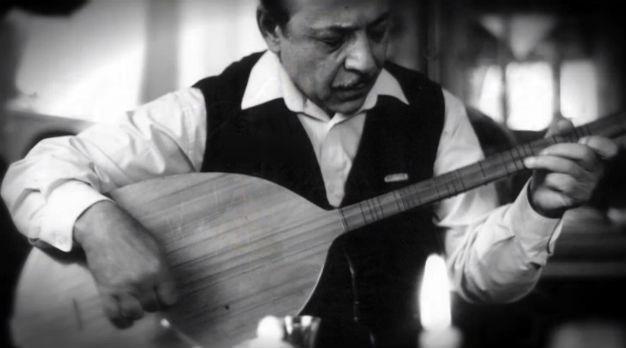Biopic looks at the life of great bard Neşet Ertaş
Emrah Güler

As bizarre as it might sound, the name that stuck with the late Neşet Ertaş, one of Turkey’s greatest musicians, was the “Plectrum of the Steppe.” As the story goes, a group of Ertaş fans bought a book by legendary Turkish writer Yaşar Kemal and sent the book to Ertaş, who was serving time in a prison in Yugoslavia, as a gesture of their support. Inside the cover, they wrote, “To the Great Plectrum of the Steppe,” and each signed their name.
Soon, Ertaş wrote them a letter, ending it with, “See you in heaven that is Istanbul.” When Ertaş was released and came back to Istanbul to perform, he received flowers for his first show, with a card which read:
“To the Great Plectrum of the Steppe, Welcome to the heaven that is Istanbul.” So was the beginning of a long-lasting friendship between the artist and his fans, and a name that would stick with Ertaş for life.
Three-and-a-half years after his death, his life story has been told in detail in a documentary titled “Ah Yalan Dünyada: Neşet Ertaş” (referring to his famous song “Ah Yalan Dünya,” The Delusion of Life), co-directed by Atalay Taşdiken and Hacı Mehmet Duranoğlu. The film includes over 30 interviews with musicians, journalists, music critics and those close to him.
Ertaş’s inviting voice, accompanied by the strings of his bağlama, had made him the modern-day traveling bard of the Anatolian Alevi tradition of centuries past, a historic image personifying Anatolian folk music. He had been a household name in Turkey for half a century. The overpowering nostalgia in his music, personal revelations shrouded in melancholy and an ode to the life in and a history of Central Anatolia were the defining characteristics of his music.
“There are 40 of us; we all know each other very well,” he had said in an interview with Haşim Akman for “Neşet Ertaş Kitabı” (The Neşet Ertaş Book), published in 2006. “I have come to know with certainty. / Whatever people say, / Each bard, each poet, each lover, each scientist, / Whatever they say, they say for love…”
The Central Anatolian blues
Ertaş’s music can perhaps best be called the blues of Central Anatolia, home to the bozlak, the rhapsodic, at times improvised music by the bards. His work included a vast array of traditional music, including the works of the pre-modern Turkmen bards such as Karacaoğlan and Dadaloğlu.
However, the greatest inspiration for Ertaş’s music might be much closer to home: His father, the late Muharrem Ertaş, a folk poet and singer as well. When Neşet Ertaş was young, he and his father appropriated the tradition of the traveling bard to their lifestyle, traveling from village to village in Middle Anatolia, playing their bağlamas and singing at weddings. Upon his wish, Neşet Ertaş was to be buried next to his father.
Traveling was always an integral part of Ertaş’s life and career, as he moved from his hometown of Kırşehir to Ankara in the early 1950s, playing initially in night clubs and weddings. Later, he moved to Istanbul and released his first album. As his career flourished in dozens of concerts to adoring crowds and new albums, he moved back to Ankara, and later to Germany in the 1970s for a medical treatment, only to stay there.
In 2000, a concert in Istanbul marked Ertaş’s comeback. Following the three-hour concert to a full auditorium in Istanbul’s Cemil Topuzlu Harbiye Open Air Theater, Ertaş received the Ahilik Art Award, the award presented to him by a state minister.
The comeback, chronicled in detail in the film, also marked two books and a documentary series on Ertaş, a late acknowledgment by his country.
The film takes a look many of the milestones in Ertaş’s career, like how he had refused the State Artist title coveted by many, on grounds that he was “the people’s artist” and would “be happy to have it stay that way.” A meticulous work of thorough research, the film incorporates much rare footage, a true gem for fans and those interested in taking a glimpse into the life of an artist who was given UNESCO’s “National Living Human Treasure” award.
 As bizarre as it might sound, the name that stuck with the late Neşet Ertaş, one of Turkey’s greatest musicians, was the “Plectrum of the Steppe.” As the story goes, a group of Ertaş fans bought a book by legendary Turkish writer Yaşar Kemal and sent the book to Ertaş, who was serving time in a prison in Yugoslavia, as a gesture of their support. Inside the cover, they wrote, “To the Great Plectrum of the Steppe,” and each signed their name.
As bizarre as it might sound, the name that stuck with the late Neşet Ertaş, one of Turkey’s greatest musicians, was the “Plectrum of the Steppe.” As the story goes, a group of Ertaş fans bought a book by legendary Turkish writer Yaşar Kemal and sent the book to Ertaş, who was serving time in a prison in Yugoslavia, as a gesture of their support. Inside the cover, they wrote, “To the Great Plectrum of the Steppe,” and each signed their name.